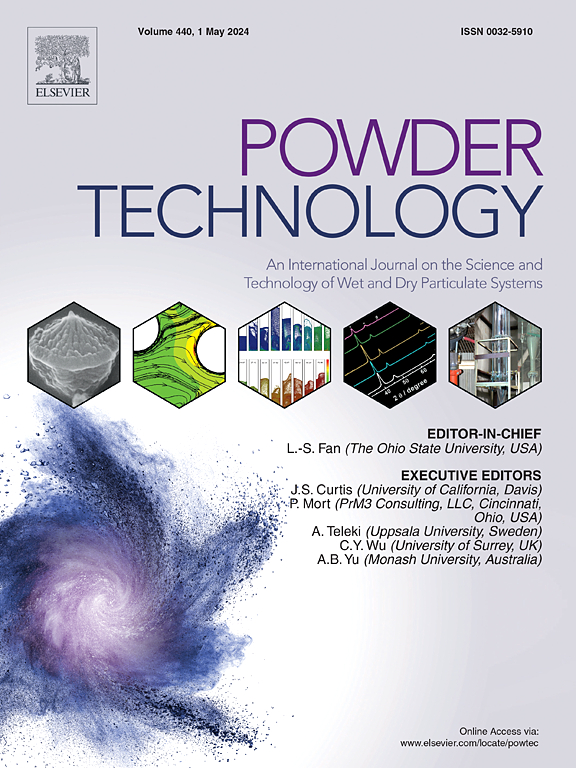20 L球内颗粒分布对粉尘爆炸的影响
IF 4.5
2区 工程技术
Q2 ENGINEERING, CHEMICAL
引用次数: 0
摘要
规范粉尘爆炸的安全特性对减轻粉尘爆炸对过程工业的影响至关重要。20 L球体主要研究实验室水平粉尘爆炸的安全特性,即爆炸压力(Pex)和压力上升率(dP/dt)ex)。确保球体内均匀的粉尘分布对于准确的数据采集和标准化至关重要。然而,通过喷嘴的气流产生的涡流使颗粒在点火前在壁面附近集中。为了研究近壁颗粒浓度对爆炸安全特性的影响,模拟了20 L球体内的爆炸过程。基于欧拉-拉格朗日方法的OpenFOAM模型以石松粉尘爆炸实验数据为基准。新的径向均匀性参数Φ(0≤Φ≤1)量化了近壁颗粒浓度。参数Φ使用基于粒子坐标径向分量的幂律计算,Φ=1表示均匀分布,Φ=0表示所有集中在壁上的粒子。不同的颗粒分布(Φ=0.1,0.2,…,1)在点火前开始。当Φ从1开始减小时,Pex和(dP/dt)ex先减小,但超过某一点后,两个参数都增大。在Φ=0.1时,Pex和(dP/dt)ex均达到最大值,分别比均匀分布高1.75%和10.1%。最低值出现在Φ=0.7处,与均匀分布相比分别降低了0.25%和5.6%。因此,高的近壁浓度会提高爆炸强度,而中等浓度会导致爆炸强度低于均匀分布。本文章由计算机程序翻译,如有差异,请以英文原文为准。

Influence of the particle distribution on dust explosions in the 20 L sphere
It is essential to standardize the safety characteristics of dust explosions to mitigate their impact on the process industries. The 20 L sphere primarily investigates the safety characteristics, namely explosion pressure () and the rate of pressure rise (), of dust explosions at the laboratory level. Ensuring uniform dust distribution inside the sphere is essential for accurate data acquisition and standardization. However, whirls created by the incoming flow through the nozzle yield particles to concentrate near the wall before ignition. This study simulated the explosion inside a 20 L sphere to investigate the impact of near-wall particle concentration on the safety characteristics. The OpenFOAM model based on the Euler-Lagrangian approach was benchmarked against experimental data of lycopodium dust explosions. A novel radial homogeneity parameter quantifies the near-wall particle concentration. The parameter is calculated using a power law based on the radial component of particle coordinates, indicating a uniform distribution, and for all particles concentrating on the wall. Different particle distributions () are initiated before ignition. As decreases from 1, and first decrease, but beyond a certain point, both parameters increase. At , both and reach their highest values, which are 1.75% and 10.1% higher than the uniform distribution, respectively. The lowest values arise at , with reductions of 0.25% and 5.6% compared to the uniform distribution. Thus, high near-wall concentrations enhance explosion intensity, while moderate concentrations result in lower intensity than the uniform distribution.
求助全文
通过发布文献求助,成功后即可免费获取论文全文。
去求助
来源期刊

Powder Technology
工程技术-工程:化工
CiteScore
9.90
自引率
15.40%
发文量
1047
审稿时长
46 days
期刊介绍:
Powder Technology is an International Journal on the Science and Technology of Wet and Dry Particulate Systems. Powder Technology publishes papers on all aspects of the formation of particles and their characterisation and on the study of systems containing particulate solids. No limitation is imposed on the size of the particles, which may range from nanometre scale, as in pigments or aerosols, to that of mined or quarried materials. The following list of topics is not intended to be comprehensive, but rather to indicate typical subjects which fall within the scope of the journal's interests:
Formation and synthesis of particles by precipitation and other methods.
Modification of particles by agglomeration, coating, comminution and attrition.
Characterisation of the size, shape, surface area, pore structure and strength of particles and agglomerates (including the origins and effects of inter particle forces).
Packing, failure, flow and permeability of assemblies of particles.
Particle-particle interactions and suspension rheology.
Handling and processing operations such as slurry flow, fluidization, pneumatic conveying.
Interactions between particles and their environment, including delivery of particulate products to the body.
Applications of particle technology in production of pharmaceuticals, chemicals, foods, pigments, structural, and functional materials and in environmental and energy related matters.
For materials-oriented contributions we are looking for articles revealing the effect of particle/powder characteristics (size, morphology and composition, in that order) on material performance or functionality and, ideally, comparison to any industrial standard.
 求助内容:
求助内容: 应助结果提醒方式:
应助结果提醒方式:


